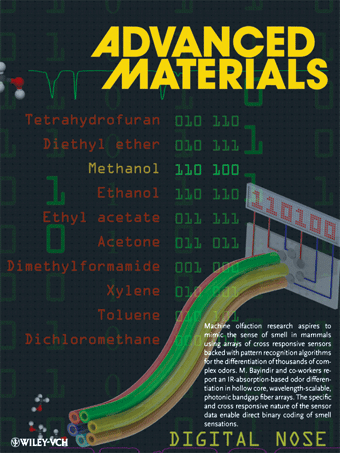Sniffing with Nanotechnology
Bilkent scientists devise a digital photonic nose for machine olfaction
Given that the sense of smell might seem unavailingly evanescent and the most inimitable of all senses, how could one ever think of registering the refreshing smell of morning coffee, the fragrance hovering a jasmine garden, or the fresh  citrus scent of a bergamot blend? Individuals who have an exceptionally keen sense of smell and retentive olfactive memory certainly help, but they will eventually suffer from olfactory fatigue. Machine olfaction research, by mimicking biological sense of smell to differentiate blends, aspires to make electronic noses that can exactly do this. One day electronic noses may be used for environmental monitoring of toxic gases or for automatically eliminating spoiled food on supermarket shelves, and perhaps even achieving the classical Greek physician and philosopher's ideal of diagnosing patients from their exhaled breath. But for all that to materialize and to compel heady scents to succumb themselves to computation, the chemosensory transducing mechanism interpreted as a smell sensation in the limbic system must be understood and copied with a sensitivity and selectivity that still belongs to a near future.
citrus scent of a bergamot blend? Individuals who have an exceptionally keen sense of smell and retentive olfactive memory certainly help, but they will eventually suffer from olfactory fatigue. Machine olfaction research, by mimicking biological sense of smell to differentiate blends, aspires to make electronic noses that can exactly do this. One day electronic noses may be used for environmental monitoring of toxic gases or for automatically eliminating spoiled food on supermarket shelves, and perhaps even achieving the classical Greek physician and philosopher's ideal of diagnosing patients from their exhaled breath. But for all that to materialize and to compel heady scents to succumb themselves to computation, the chemosensory transducing mechanism interpreted as a smell sensation in the limbic system must be understood and copied with a sensitivity and selectivity that still belongs to a near future.
The exact chemical interaction that produces the sense of smell in mammals still awaits determination of the structure of the sensory receptors situated at a mucous membrane at the upper tract of the nasal cavity, which interact with smell producing airborne organic molecules. Notwithstanding the fact, there exists a score of ways to make an electronic nose that is at least good in mechanizing one aspect of the sensation, for example by monitoring the conductance semiconductors upon ligand binding, or by organometallic proteins that selectively change color in response to odorant chemicals. A new contender just has been produced by a multidisciplinary team of scientists at the UNAM-Institute of Materials Science and Nanotechnology and Department of Physics. Writing in Advanced Materials, the researchers headed by Asst. Prof. Mehmet Bayındır, assert their "nose" has performance metrics and features that make it unique. According to one of the peer reviewers, who was not involved with the research, "the device is ready" for commercialization to be employed in medicine, industrial, and environmental sensing.
"It all started with a perchance but alert observation," says UNAM Ph.D. candidate Adem Yıldırım, the leading author of the paper. "We were producing hollow fibers for laser delivery that has nothing to do with electronic noses. That is, until we realized that the fibers were extremely sensitive to the presence of chemicals." Then they quickly realized the potential of an array of such fibers. Researchers have shown they can differentiate twelve chemicals and their mixes by using six fibers, and using computer simulation, they showed the potential of differentiating hundreds of thousands of chemicals. "This is the first time to use wavelength scalable nanostructured fibers for extended chemical sensing," says Asst. Prof. Bayındır. He expects more of these groundbreaking innovations: "The cultivation of a diverse, interdisciplinary research base often sparks ideas that rarely come from more focused groups."
The fiber nose, with its six nostril like hollow tubes, comprise the active sensors designed and fabricated at the in-house fiber-drawing facility at UNAM. These special fibers have perfect mirrors in their inner surface consisting of nanoscale multilayers. Layers thinner than one thousandths of a human hair (down to 20 nm thickness) are produced by a novel top-down fabrication technique in nanotechnology. The fibers are then cut and aligned in front of a glowing wire to make an optofluidic infrared absorption cell. The system enables binary representation of the absorption spectrum of a molecule, opening the way to possibly digitize smell from complex blends. This interesting feature was made possible by the cross responsive nature of the sensors which mean that each fiber is partly sensitive to a large set of odor producing molecules. The researchers claim that the selectivity and sensitivity of the device approaches real noses. The team has already undertaken research to determine the ultimate sensitivity of their fiber based sensing device.
A portable electronic nose can be very handy in many unexpected ways. Think of your smart phone featuring a tiny chemo-sensor that smells the environment just as its microphone records environmental sound. It sounds fun, but it can be put to nobler ends: Nobel Laureate Linus Pauling in the 1970s made the first analytical studies of exhaled breath analysis using gas chromatography to see for himself if the ancient speculative philosopher was indeed right. Dr. Mecit Yaman, a postdoctoral associate who is involved in the research, muses "equipped with such a sensor, smartphones can quietly track the health status of its owner, sharing it with his/her doctor, thereby storing the medical record of the nation on the cloud to produce a gross domestic health record, perhaps."